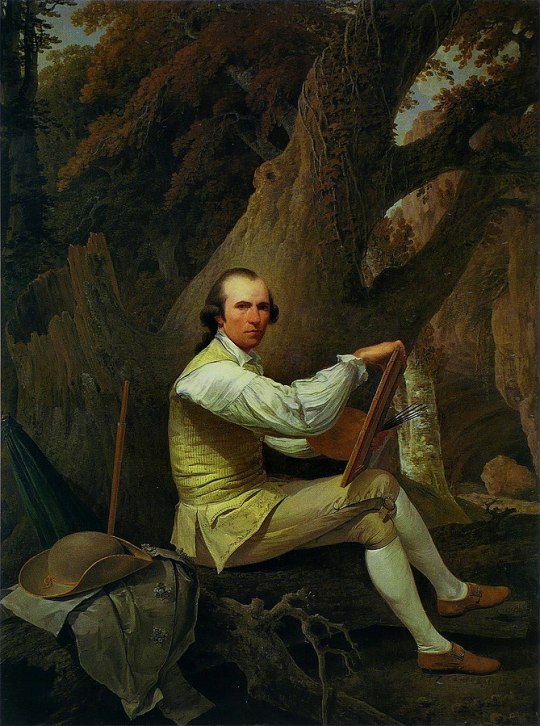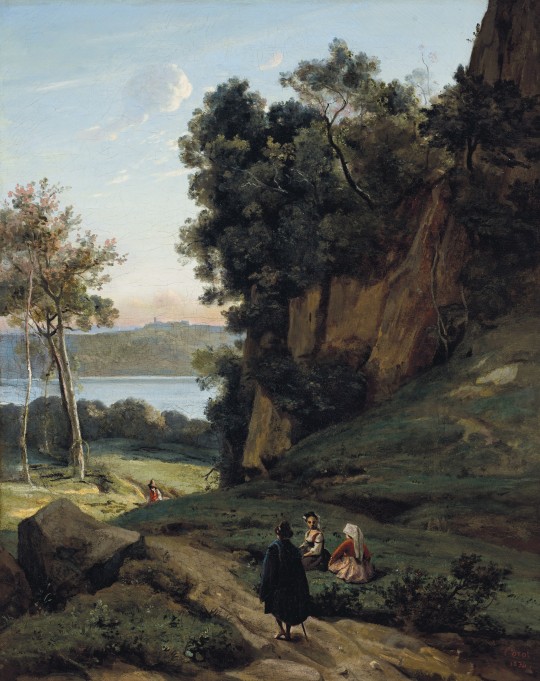#Gaspard Dughet
Link
Gaspard Dughet, also known as Gaspard Poussin, was a French painter born in Rome.
Link: Gaspard Dughet
0 notes
Text

Adriaen Frans Boudewijns - Port view -
Adriaen Frans Boudewijns (Brussels, 3 October 1644 – Brussels, 3 December 1719) was a Flemish landscape painter, draughtsman and etcher. He was known mainly for his landscapes with trees, Italianate landscapes with architecture, rivers and villages, city, coast and country views and architectural scenes.
Boudewijns' work combines the Northern tradition of landscape painting with the Roman classicism exemplified by Claude Lorrain and Poussin. His landscapes often show landscapes bathed in a bright southern glow, occasionally with an ancient architectural element, against a lively and naturalist sky with clouds. These Classical idealized landscapes became Boudewijns' trademark. His meticulous rendering of trees shows the influence of Gaspard Dughet. All his landscapes are meticulously painted and often peopled with figures painted by Pieter Bout.
The landscapes of Boudewijns can generally be divided into three types. The first type resembles the work of the Sonian Forest school of landscape painters such as Jacques d'Arthois and Cornelis Huysmans. These painters from Brussels had a preference for depicting sand flats with deep lying roads surrounded by trees. These compositions show the landscapes in a bright light. A second type of landscape depicts Italianate architectural elements set in a flat landscape with a row of hills as a backdrop. Finally, he made a number of village and river landscapes that recall the style of Jan Brueghel the Elder in compositional structure and technical precision.
Boudewijns' many prints were based on paintings or designs of Adam Frans van der Meulen, Abraham Genoels and on his own designs.
11 notes
·
View notes
Photo

Jacob More - Self portrait - 1783
Jacob More (1740–1793) was a Scottish landscape painter.
Jacob More was born in 1740 in Edinburgh. He studied landscape and decorative painting with James Norie's firm. He took the paintings of Gaspard Dughet and Claude Lorrain as his models.
By 1773 More had settled in Italy, and spent the rest of his life there; but he exhibited Italian landscapes at the Royal Academy in London in the 1780s.
In 1787 he was visited by Goethe, who considered his work 'admirably thought out'.
In 1791 he moved to Rome. In Italy he rivalled Jacob Philipp Hackert; and he befriended Allan Ramsay (1713-1784). In Rome he enjoyed a high reputation, and was commissioned to design a garden for the Villa Borghese in the Scottish landscape style.
13 notes
·
View notes
Text
La Normandie et les peintres 3
La Normandie et les peintres 3

View On WordPress
#Adolphe La Lyre#Armand Le Véel#Armand Leleux#Balthasar Ommeganck#Brueghel l&039;ancien#Charlemagne#Cherbourg#Christian Wilhelm Ernst Dietrich#Cristofano Allori#Filippo Lippi#François Ier#Gaspard Dughet#Gaston Bussière#Geneviève de Brabant#Giuseppe Canella#Govaert Flinck#Hendrick Van Balen#Horace Vernet#J.-F. Millet#Jacopo Palma#Jacques-Antoine Vallin#Jean-Baptiste Mallet#Jean-Baptiste Oudry#Jean-François Demay#Jeanne d&039;Arc#Lacenaire#Lannes (maréchal)#Le Livre des Juges#Les enfants du paradis (film)#Louis Montvignier
6 notes
·
View notes
Photo

Attributed to Gaspard Dughet, called Gaspard Poussin (Rome 1615-1675) - The Death of Procris
1 note
·
View note
Text
A Rationalist No Longer
Horace, Odes 1.34
Note: “a mad philosophy”: Epicureanism, which attributed physical phenomena to the movement of atoms rather than divine intervention.
Once I worshiped the gods in a fashion
Miserly and rare,
While I went astray, so learned
In a mad philosophy;
Now I am compelled to sail
Backward, and take up
Afresh a course before abandoned.
For the Sky-Father,
Usually wont to rend the clouds
With his flashing lightning,
Drove his thundering horses and
His flying chariot
Through a clear sky. And with that driving,
The heavy earth, the rivers
That meander, the Styx, the dreadful
Seat of hated Taenarum,
And Atlas, the world’s western limit-
All of them were shaken.
The god has power to exchange
Lowest things with highest;
He dims the glow of the famous man
And brings the hidden to light.
Greedy Fortune, with a shriek
That pierces, snatches off
The crown from one man’s head and joys
To set it on another’s.
Parcus deorum cultor et infrequens,
insanientis dum sapientiae
consultus erro, nunc retrorsum
vela dare atque iterare cursus
cogor relictos: namque Diespiter
igni corusco nubila dividens
plerumque, per purum tonantis
egit equos volucremque currum,
quo bruta tellus et vaga flumina,
quo Styx et invisi horrida Taenari
sedes Atlanteusque finis
concutitur. Valet ima summis
mutare et insignem attenuat deus,
obscura promens; hinc apicem rapax
Fortuna cum stridore acuto
sustulit, hic posuisse gaudet.

Landscape with Lightning, Gaspard Dughet, 1667-69
#classics#tagamemnon#Latin#lingua latina#poem#poetry#translation#Latin language#Latin translation#Horace#Q. Horatius Flaccus#lyric poem#lyric poetry#Roman religio#religio Romana#Jupiter#Zeus#ancient philosophy#Epicureanism#Gaspard Dughet
151 notes
·
View notes
Photo

Gaspard ‘Poussin’ Dughet. Stormy Landscape with Figures, c.1635
0 notes
Photo

Landschaft mit Dorfbewohnern, um 1640
von Gaspard and Miel, Jan van Dughet
Öl auf Leinwand
Fitzwilliam Museum, University of Cambridge, UK
#Gaspard and Miel#Jan van Dughet#landschaft#landschaftsmalerei#kunst#gemälde#meisterwerk#kunstdruck#museum#galerie#kunstwerk#alte meister
6 notes
·
View notes
Photo

Gaspard Dughet (1615 - 1675) - Landscape with trees, mountains and figures
23 notes
·
View notes
Photo

Italiens d’Albano by Jean-Baptiste-Camille Corot, 1834
In the early years of the 19th century there were two approaches to landscape taken in French art. The classical tradition, modeled after the great Italian landscapists Annibale Carracci and Salvator Rosa and the French painters Nicolas Poussin, Claude Lorrain and Gaspard Dughet, was experiencing a renaissance, fueled by the theories of Pierre-Henri de Valenciennes. These artists maintained the idealized historical landscape while at the same time renewing it with a more realistic depiction of nature. The artists who embraced this ideology all traveled to Italy, were inspired by the great French and Italian masters of the 17th century, and were all painters of historical landscapes, humanistic in approach and recomposed in the studio. During his early years, and under the tutelage of Achille-Etna Michallon, the young Camille Corot was introduced to this school of artistic thought.
In contrast to this imaginary, idealized landscape of the Neoclassicists, another approach to painting was realistic, intimate and faithful to the topography of the actual sites, drawing more on the example of Dutch and Flemish painters of the 17th and 18th centuries. These two tendencies should not be viewed as opposites and the ease with which the French painters of the early 19th century assimilated aspects of both theories cannot be ignored. Admiration for Poussin was compatible with enthusiasm for Ruisdael, while embracing the work of Claude did not discount the contributions of Hobbema.
At this time, French artists also discovered the realism of the late 18th century English landscape artists, particularly that of John Constable and Joseph Mallord William Turner. These English artists set forth a new vision with an emphasis on realism and expressiveness which would also influence Corot throughout his long career.
Corot entered the studio of Michallon in 1822 where he threw himself into landscape painting. Michallon died shortly thereafter, but he exerted a profound influence on the young Corot who wrote: ‘I made my first landscape from nature at Arceuil under the eye of this painter, whose only advice was to render with the greatest scrupulousness everything I saw before me. The lesson worked; since then I have always treasured precision’ (T. Silvestre, Histoire des artistes vivant, français et étrangers: Études après nature, Paris, 1853, p. 75).
Michallon passed on to Corot his feelings for the Classical landscape tradition and through his first teacher, Corot developed the foundation of his own art, finding a balance between the realism of plein-air painting and the application of memory and imagination to works composed in the studio.
The young artist made his first trip to Italy in 1825 and remained there until 1828. While there he made numerous landscape and figure studies, architectural studies and spent a great deal of time studying the effects of light created by moving or still water and worked to master the play of light in space. Once back in France, Corot took great satisfaction in his Italian stay. He had amassed numerous studies which now embellished the walls of his studio, he had developed an excellent and unique technique for capturing nature and he had grappled with and succeeded at composing a large studio landscape which had been accepted by the Salon.
For Corot at this time, the study was an essential element that preceded the studio landscape. When working in the studio itself, the artist could dispense with the study, and instead rely on his memory and impressions. Italy had nourished his visual memories, and it was in this moment that Corot developed his passion for creating the souvenirs which would so dominate his later artistic career. The views he painted entirely or partially from nature on his return from Italy are regarded as among his most beautiful and accomplished. The artist demonstrated a complete mastery of perspective, light and construction that would pervade his life’s work and serve to inspire a generation of artists that would follow him.
In the years immediately following his return from his first trip to Italy, Corot exhibited frequently and regularly at the Salon. In 1831, he exhibited four paintings, in 1833, he exhibited one painting, and then in 1834, he showed three paintings, probably including the present lot under the title Site d’Italie. During this period, the paintings that he showed at the Salon had essentially two themes: views based upon his studies and memories of his trip to Italy, and views of the forest of Fontainebleau.
Italiens d’Albano was composed in Corot’s studio in 1834, most likely just before his second trip to Italy which lasted only six months. The work incorporates the artist’s memories of this picturesque area just outside Rome where he spent a significant amount of time during his first excursion abroad. The classical influence of his formative years under the tutelage of Michallon and his second teacher Jean-Victor Bertin is clearly demonstrated in Italiens d’Albano; however, all of the elements that contributed to the successes of his later career and earned him the title ‘Poet of the Landscape’ are evident in this charming painting.
The artist has adroitly mastered the aerial perspective, leading the eye of the viewer from a point above the landscape itself, down the winding path, through the light green meadow and to the shores of Lake Albano. The artist’s penchant for dividing the landscape into distinct fore, middle and background is accomplished with the addition of figural groups; the caped figure walking the path by the two seated women, the man in the red vest walking up the hill, the shoreline of Lake Albano and the architectural element in the far background all work together seamlessly to take the viewer on a walk through a landscape. The effects of light and shadow on the landscape itself, from the darkened rocky outcroppings that dominate the right side of the painting, to the sunlight illuminating the middle ground, to the shimmering water under the clear Italian sky in the near background, demonstrate the burgeoning abilities of an artist who would ultimately become the spiritual link between Poussin and Sisley, Claude Lorrain and Monet.
20 notes
·
View notes
Photo

Landscape with a Herdsman and Goats, Gaspard Dughet, 1630, Art Institute of Chicago: European Painting and Sculpture
Restricted Gift of Mrs. Albert J. Beveridge
Size: 26 3/4 × 47 7/16 in. (68 × 120.4 cm)
Medium: Oil on canvas
https://www.artic.edu/artworks/45829/
8 notes
·
View notes
Photo

Imaginary Landscape, Gaspard Dughet, European Paintings
Rogers Fund, 1908
Size: 37 7/8 x 60 1/2 in. (96.2 x 153.7 cm)
Medium: Oil on canvas
https://www.metmuseum.org/art/collection/search/436229
6 notes
·
View notes
Photo

Gaspard Dughet - Wooded landscape with Apollo, Daphne and Perseus (c.1650).
#Gaspard Dughet#Wooded landscape with Apollo Daphne and Perseus#apollo and daphne#Apollo#Daphne#Turned into tree#Metamorphoses#Perseus
0 notes
Photo

Mountainous Landscape, Gaspard Dughet, Mauritshuis Museum
https://www.europeana.eu/portal/record/2021672/resource_document_mauritshuis_320.html?utm_source=api&utm_medium=api&utm_campaign=j4AoMQNzp
6 notes
·
View notes

